The flow of ingenuity
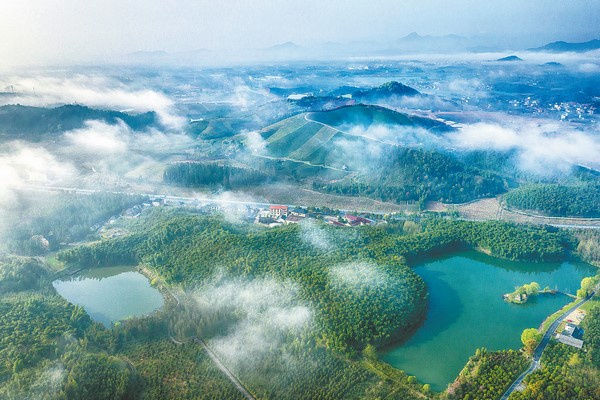
The extensive water conservancy system built by the Liangzhu people five millennia ago still benefits the local people today. Here, the Qiuwu Site and the Shiwu Site of the high-dam system help form two reservoirs. CHINA DAILY
Discovery of a vast and intricate water conservation system shows the inventiveness of the ancient Liangzhu civilization in its bid to harness nature, Zhao Xu reports.
'Nothing is softer or more flexible than water, yet nothing can resist it," said ancient Chinese philosopher Laozi (Lao Tzu), who lived around the 6th century BC. The man, whose words still resonate powerfully with Chinese today, had no knowledge of the existence of the ancient city of Liangzhu, built around 3000 BC, at a time when the Chinese civilization, to which Laozi had contributed, was fast taking shape. Yet for those in the know, his remarks on water seem to sum up the history of Liangzhu, both the civilization and the city — the latter of which is known as "China's Neolithic Venice".
"The element of water is so integral to the story of Liangzhu, from the beginning to the very end," says Wang Ningyuan, who today is in charge of all the excavation done at the Archaeological Ruins of Liangzhu City, a UNESCO World Heritage Site in Hangzhou, Zhejiang province. "Water presented the Liangzhu people with both opportunities and challenges. To exploit the opportunities they took on the challenges; and in taking on the challenges they created something truly remarkable — a city sitting on a river-veined land and a civilization that stood proudly ahead of all its contemporaneous Neolithic cultures."
That land covers the lower reaches of the Yangtze River and the area surrounding the Taihu Lake, China's third-biggest freshwater lake. Today, it is one of China's major rice-producing regions. Those who decided to settle down here 5,000 years ago clearly had the lowland's vast potential in mind, says Wang.
"They knew that this fertile land, if properly tended, would give them what they needed for survival and more. Yet, at the same time, they were by no means ignorant of the dangers posed by water," he says.
Circled by mountains on three sides (north, west, and south), with only one side open to the alluvial plains and the funnel-shaped Hangzhou Bay to its east, the land of Liangzhu was particularly vulnerable to this natural element. Flooding and typhoons would come from the sea. The monsoon season lasted from April to October — it still does these days. The mountains only serve to increase precipitation by cooling off the rain-laden clouds as they climb their windward slopes.
"The downsides were obvious, but the Liangzhu people eventually decided that they were outweighed by the upsides," says Wang. "However, instead of subjecting themselves to the whims of nature, which they worshiped fervently, they went all out to shape their own destiny and proved their ingenuity as planners, surveyors, builders and engineers."
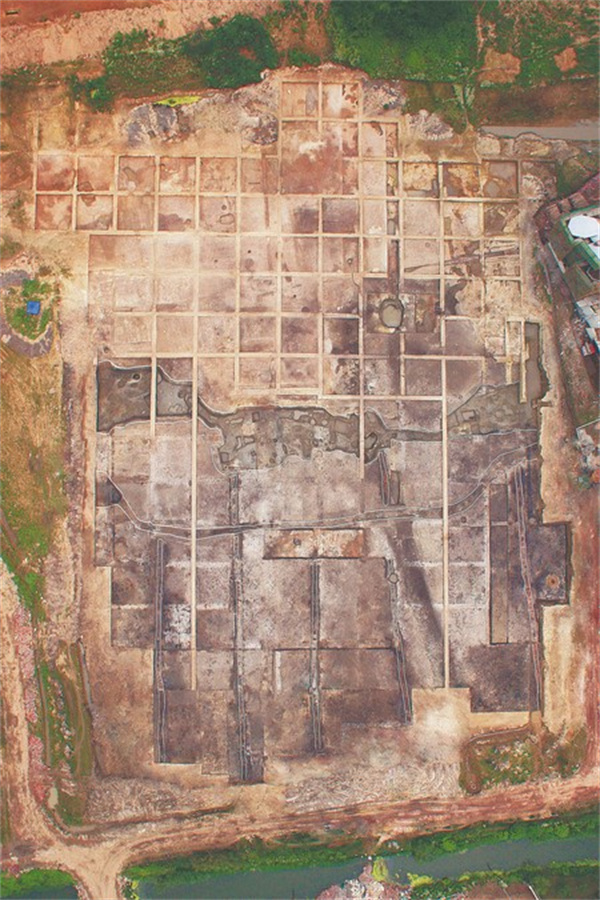
An ancient Liangzhu paddy field with irrigation canals and field ridges. CHINA DAILY
Generational effort
Nowhere else was this ingenuity put on more irrefutable display than with Liangzhu's extended water conservancy system, so far the earliest discovered in China on such a scale. It was composed of three parts: the high-dam system at the mouth of the valley, the low-dam system down on the plain and a 5,500-meter-long, 2.7-meter-high embankment erected along the southern foothill of the Dazhe Mountain — 2 kilometers further south is where Liangzhu City's palatial complex was being built.
"These days, we often talk about the 11 dams that had made up Liangzhu's water system, but, in fact, more than 30 such dams have been discovered to date," says Wang.
Among them, they formed three reservoirs with surface area totaling 13.29 million square meters. Collectively, they were capable of holding more than 46 million cubic meters of water. During the rainy season, the reservoirs would collect the water rushing down from the mountains, preventing it from flooding the acres of paddy fields on the low plains, while saving it for use during the dry season that would follow. (Despite popular belief, every year for a certain few months, severe drought ravages the area, threatening the survival of crops.)
"One story I heard about the dams is that, around 2005, workers from a local construction company were digging up earth considered ideal to build their own dam, at a place in the mountains called Laohuling (the Tiger's Ridge)," says Wang. "No one had any idea that they were actually digging at an ancient Liangzhu dam until four years later, when archaeologists made their discovery on the same spot of an earth dam running for about 135 meters in a northwest-southeast direction," says Wang.
"Of course no digging is allowed since that discovery. But the workers were absolutely right in thinking that the earth there was the best choice."
According to Wang, to understand the Liangzhu dams, one only needs to look at the modern-day core dams — dams with a central section or core composed of an impermeable material to stop water from seeping through it. These days, the cores are routinely made of clay or concrete, and are often surrounded on the outside by compacted rockfill which is responsible for the stability of the embankment body.
"The Liangzhu dams were no different, except that the Liangzhu people used something else," Wang says. "In place of the rockfill they had residual soil, developed as a result of the weathering of rocks. This type of soil, after ramming, becomes so stable that it would neither crack under the heat of sun, nor collapse during a downpour. No wonder the workers wanted it."
On the other hand, the Liangzhu people's answer to the clay core was a sedimentary silt, an extremely thick, gluey sludge found in the swamps. Believed to be even more impervious to water than clay, the same material was used around 2,800 years later, during China's Western Han Dynasty (206 BC-AD 24), to seal off the coffin of an aristocratic lady, keeping the tomb-owner completely intact until her discovery in the early 1970s.
At the Liangzhu dams, the silt was either used alone or as oval-shaped, straw-wrapped silt blocks, each approximately 40 centimeters long. The latter, often found on the upstream side of the dam, can be compared to the sandbags commonly used nowadays to prevent flooding. And the arrangement of these bags, laid on top of one another in a crisscross pattern, also allowed the straws to function as reinforcement for the structure.
"The Liangzhu people made the most of what they had at hand: the soil, the silt, the silver grass growing in the marshes, and their spare time," says Wang. Further sample analysis shows that the grass used to bundle up the silt was only cut off for use after its annual flowering, that is, during the dry autumn and winter seasons — downtime for local farmers then and now.
Therefore, the system took decades and generations to build — the total volume of soil needed to construct Liangzhu's water conservancy system is estimated at 2.88 million cu m. Behind that number is the enormous cost in terms of human labor, and the vision and power that motivated that labor.
"Judging by how the dams worked with one another, the entire project was planned out and thought through from its outset," says Wang, who in 2011 hit upon the idea that the dams were an interconnected whole while studying a picture taken of the area by a US reconnaissance satellite back in the 1960s.
"There, between two mountains is a short white line bridging them together. After being discontinued, that line seems to have re-picked itself up and run intermittently, extending to the northeast, before veering eastward," Wang recalls. "That's when it clicked in my head."
What the experienced map-reader was looking at was a series of dams which had collectively formed the lowdam system leading up to the embankment in front of the Dazhe Mountain.
"One intriguing aspect about this embankment, or causeway as some call it, is that it was partly a doubledam structure. A certain section of it actually features two dams running parallel to each other, effectively forming a canal between themselves," says Wang.
On its east side, the structure is open-ended, and was most probably connected to a natural river. This has led archaeologists to speculate that the double-dam may have served to channel water into the river and eventually into the city, the traffic of which was mainly waterborne.
But there may never be a definite answer, according to Wang. "The structure of the embankment is so complicated that we may never be able to completely decipher all its secrets. However, there's one thing that we know for sure: Like all other dams and reservoirs in the Liangzhu water conservancy system, it served multiple purposes. Transportation was probably one of them."
But were the Liangzhu people heavily rewarded by their gargantuan project and their heroic efforts to harness nature and bend it to their advantage? "Without that effort, the Liangzhu civilization wouldn't have existed," Wang concedes.
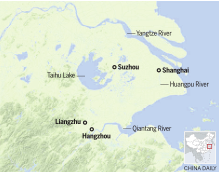
The location of Liangzhu site. CHINA DAILY
Experts in the fields
Within Liangzhu's walled city, at the center of which is the palatial complex, archaeologists have discovered three granaries. While two of them are situated on the western and eastern slopes of the complex, which sits on an earthen platform, the third one lies to the south, about 100 meters from the platform's southern edge.
"In the last one of the three, we've discovered two huge layers of carbonized rice, with one on top of the other. Covering an area of more than 10,000 square meters, the two layers together reach an average thickness of 60 centimeters. It seems that they are both the result of big fires that had ravaged the granary on two separate occasions," Wang says.
"The total amount of rice destroyed is estimated at 100,000 kilograms, the number itself shedding light on the rice production capacity of the Liangzhu society," says Wang, who put Liangzhu's estimated rice yield per mu at 140 kg. (One mu is equal to 666.7 square meters.)
"To put this number into context, in the 1940s, some areas in China still had a rice yield per mu of 300 kg. Keeping in mind that the Liangzhu civilization prospered between 3300 BC and 2300 BC, the people there were not doing badly — in fact, they were doing pretty well."
These days, visitors to the Shanghai Museum can try to imagine this agrarian lifestyle, through many Liangzhu farming tools on display as part of the exhibition The Proof of Early China. These include stone sickles, spades and a plowshare composed of multiple parts. The last one — so heavy that it could only be pulled by big farm animals like oxen — was probably a Liangzhu invention.
More advanced farming tools led to higher efficiency and higher production, which in turn led to a population increase in the Yangtze River Delta region.
Within that region, large sites of ancient paddy fields have been discovered. One of them, located 20 km to the east of Liangzhu City and measuring nearly 80 mu (around 53,300 square meters), features vestiges of river courses, water damscum-causeways, irrigation canals and field ridges, the latter two dividing the fields into roughly rectangular patches, each covering between 1,000 and 2,000 square meters.
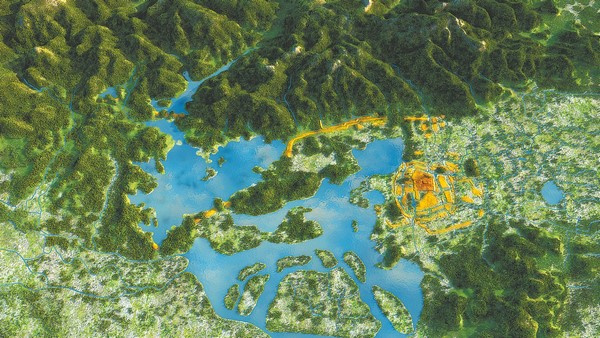
Locations of major parts of Liangzhu's water conservancy system: (1) high-dam at the mouth of the valley; (2) low-dam on the plain; (3) embankment in front of the mountains; (4) Liangzhu City. CHINA DAILY
"It's clear that during the Liangzhu era, rice cultivation in China had largely matured, becoming the base of a regional civilization, which itself lies among the roots of the Chinese civilization as we know it today," says Zhou Yun, curator of the Shanghai exhibition.
After conducting DNA testing on the rice remains from the aforementioned granaries, archaeologists have come to the conclusion that they were not of one single species, and were most likely to have come from different rice-cultivating centers scattered across the Yangtze River Delta region, mostly on the alluvial plains that separated Liangzhu City from the bay area to its east.
The location of the plains also meant that the paddy fields were the first to be affected whenever there was a marine transgression, which is exactly what many believe started to happen toward the end of the Liangzhu civilization around 2300 BC.
"They were probably caused by celestial tides, which happened regularly, say at the beginning and the middle of each month. Every time, a mixture of fresh and salty water would come in and then retreat, flooding the crops that could not sustain the saline water," says Wang. "The record of those transgressions is today kept in the multiple thin layers of silt covering large areas of the plain."
But there was probably more to it than just that. Some Chinese researchers who have looked into samples of stalagmites from caves southwest of the Liangzhu City site believe that around the time of the civilization's demise, there was a period of extremely high precipitation.
"The massive monsoons probably led to such severe flooding of the Yangtze River and its tributaries, that even the sophisticated dams and canals could no longer withstand the mass of water," says Zhang Haiwei, one of the geologist-researchers.
In face of water, nothing is impregnable.
However, the Liangzhu story will never come to a complete end as long as "water still pervades this land", says Wang.
Among other things, he was thinking about the construction workers who, even before the archaeologists, acknowledged the brilliance of Liangzhu engineering, and about the long embankment which today still forms a lake with its nearby mountain, a lake upon which the locals rely for irrigation and fish farming.
"The Liangzhu people built these structures to last," he says.





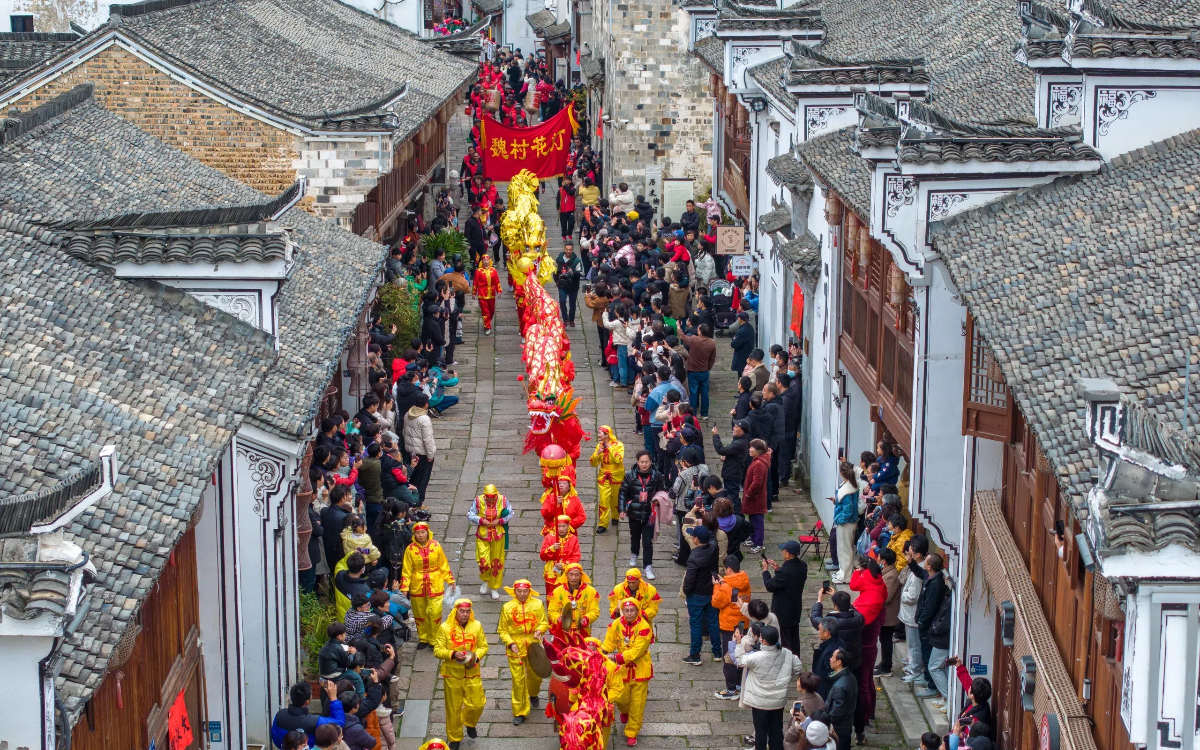 play
play